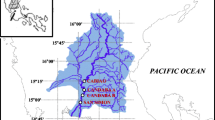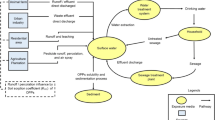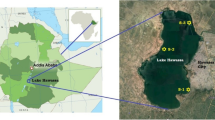Abstract
Human activities, particularly in large cities, can lead to pollution caused by micropollutants such as pesticides in water bodies, which have been recognized as serious threats to the environment and human health. The pollution level of six organophosphorus pesticides, three herbicides, and one bactericide in groundwater and the Wenyu River, and their fates in three sewage treatment plants (STPs) and a hospital were investigated in this study. The concentrations of the ten detected pesticides ranged from not detected (ND) to 323.44 ng L−1 in different water samples from Bei**g; metalaxyl was detected to have the highest concentration (89.58 ng L−1), and the detection frequencies of atrazine and metalaxyl were 100%. The maximum concentrations of pesticides in the Wenyu River, STPs, and the hospital were 1–2 orders of magnitude higher than those in the groundwater. Good removal efficiencies by the treatment processes were observed for ametryn (100%), while the removal efficiencies for atrazine and omethoate were the lowest in the three STPs (− 9.6% and 12.67%, respectively). Finally, risk quotient (RQ) values of each contaminant were estimated from the maximum values determined for typical urban to assess the ecology and health effects. In the case of environmental toxicity, the highest RQ values (> 1) were obtained for dichlorvos and omethoate. In the case of health toxicity, the RQ values show that the pesticides found in groundwater pose no potential health risks to humans at current concentrations.


Similar content being viewed by others

References
Affum AO, Acquaah SO, Osae SD, Kwaansa-Ansah EE (2018) Distribution and risk assessment of banned and other current-use pesticides in surface and groundwaters consumed in an agricultural catchment dominated by cocoa crops in the Ankobra Basin, Ghana. Sci Total Environ 633:630–640
Ali N, Khan S, Li Y, Zheng N, Yao H (2019) Influence of biochars on the accessibility of organochlorine pesticides and microbial community in contaminated soils. Sci Total Environ 647:551–560
Bei**g Statistical Yearbook (2018) China Statistics Press
Berman T, Hochner-Celnikier D, Barr DB, Needham LL, Amitai Y, Wormser U, Richter E (2011) Pesticide exposure among pregnant women in Jerusalem, Israel: results of a pilot study. Environ Int 37(1):198–203
Campo J, Masiá A, Blasco C, Picó Y (2013) Occurrence and removal efficiency of pesticides in sewage treatment plants of four Mediterranean River basins. J Hazard Mater 263:146–157
Chen H, Zhu J, Li Z, Chen A, Zhang Q (2016) The occurrence and risk assessment of five organophosphorus pesticides in river water from Shangyu, China. Environ Monit Assess 188(11):614
Cruz-Alcalde A, Sans C, Esplugas S (2018) Priority pesticide dichlorvos removal from water by ozonation process: reactivity, transformation products and associated toxicity. Sep Purif Technol 192:123–129
Derbalah A, Chidya R, Jadoon W, Sakugawa H (2018) Temporal trends in organophosphorus pesticides use and concentrations in river water in Japan, and risk assessment. J Environ Sci 79:135–152
Elfikrie N, Ho YB, Zaidon SZ, Juahir H, Tan ESS (2020) Occurrence of pesticides in surface water, pesticides removal efficiency in drinking water treatment plant and potential health risk to consumers in Tengi River basin, Malaysia. Sci Total Environ 712:136540
Evangelista S, Cooper DG, Yargeau V (2010) The effect of structure and a secondary carbon source on the microbial degradation of chlorophenoxy acids. Chemosphere 79(11):1084–1088
Glinski DA, Purucker ST, Van Meter RJ, Black MC, Henderson WM (2018) Analysis of pesticides in surface water, stemflow, and throughfall in an agricultural area in South Georgia, USA. Chemosphere 209:496–507
Hansen SP, Messer TL, Mittelstet AR (2019) Mitigating the risk of atrazine exposure: identifying hot spots and hot times in surface waters across Nebraska, USA. J Environ Manag 250:109424
Hu Y, Qi S, Zhang J, Tan L, Zhang J, Wang Y, Yuan D (2011) Assessment of organochlorine pesticides contamination in underground rivers in Chongqing, Southwest China. J Geochem Explor 111(1–2):47–55
Hua XM, Shan ZJ (1999) Production, usage and environmental influence factors of pesticides in China. Sci Technol Anhui (in Chinese) 6:6–10
Kapsi M, Tsoutsi C, Paschalidou A, Albanis T (2019) Environmental monitoring and risk assessment of pesticide residues in surface waters of the Louros River (NW Greece). Sci Total Environ 650:2188–2198
Köck-Schulmeyer M, Villagrasa M, de Alda ML, Céspedes-Sánchez R, Ventura F, Barceló D (2013) Occurrence and behavior of pesticides in wastewater treatment plants and their environmental impact. Sci Total Environ 458:466–476
Kumar S, Kaushik G, Dar MA, Nimesh S, Lopez-Chuken UJ, Villarreal-Chiu JF (2018) Microbial degradation of organophosphate pesticides: a review. Pedosphere 28(2):190–208
Lazarević-Pašti TD, Pašti IA, Jokić B, Babić BM, Vasić VM (2016) Heteroatom-doped mesoporous carbons as efficient adsorbents for removal of dimethoate and omethoate from water. RSC Adv 6(67):62128–62139
Lee HJ, Kim KY, Hamm SY, Kim M, Kim HK, Oh JE (2019) Occurrence and distribution of pharmaceutical and personal care products, artificial sweeteners, and pesticides in groundwater from an agricultural area in Korea. Sci Total Environ 659:168–176
Lewis KA, Tzilivakis J, Warner DJ, Green A (2016) An international database for pesticide risk assessments and management. Hum Ecol Risk Assess: An International Journal 22(4):1050–1064
Liu T, Xu S, Lu S, Qin P, Bi B, Ding H et al (2018) A review on removal of organophosphorus pesticides in constructed wetland: performance, mechanism and influencing factors. Sci Total Environ 651:2247–2268
Liu X, Zhang G, Liu Y, Lu S, Qin P, Guo X et al (2019) Occurrence and fate of antibiotics and antibiotic resistance genes in typical urban water of Bei**g, China. Environ Pollut 246:163–173
Mahesh GB, Manu B (2019) Removal of ametryn and organic matter from wastewater using sequential anaerobic-aerobic batch reactor: a performance evaluation study. J Environ Manag 249:109390
Man YB, Chow KL, Cheng Z, Kang Y, Wong MH (2018) Profiles and removal efficiency of organochlorine pesticides with emphasis on DDTs and HCHs by two different sewage treatment works. Environ Technol Innov 9:220–231
Masís-Mora M, Lizano-Fallas V, Tortella G, Beita-Sandí W, Rodríguez-Rodríguez CE (2019) Removal of triazines, triazoles and organophophates in biomixtures and application of a biopurification system for the treatment of laboratory wastewaters. Chemosphere 233:733–743
Mauffret A, Baran N, Joulian C (2017) Effect of pesticides and metabolites on groundwater bacterial community. Sci Total Environ 576:879–887
Meftaul IM, Venkateswarlu K, Dharmarajan R, Annamalai P, Megharaj M (2019) Pesticides in the urban environment: a potential threat that knocks at the door. Sci Total Environ 711:134612
Mijangos L, Ziarrusta H, Ros O, Kortazar L, Fernández LA, Olivares M, Zuloaga O, Prieto A, Etxebarria N (2018) Occurrence of emerging pollutants in estuaries of the Basque Country: analysis of sources and distribution, and assessment of the environmental risk. Water Res 147:152–163
Palma P, Kockschulmeyer M, Alvarenga P, Ledo L, Barbosa IR, De Alda ML, Barcelo D (2014) Risk assessment of pesticides detected in surface water of the Alqueva reservoir (Guadiana basin, southern of Portugal). Sci Total Environ 488–489:208–219.
Papadakis EN, Tsaboula A, Kotopoulou A, Kintzikoglou K, Vryzas Z, Papadopoulou-Mourkidou E (2015) Pesticides in the surface waters of Lake Vistonis Basin, Greece: occurrence and environmental risk assessment. Sci Total Environ 536:793–802
Pressley T (1982) The Determination of organophosphorus pesticides in industrial and municipal wastewater: method 622. USEPA, Washington, DC
Qu CS, Chen W, Bi J, Huang L, Li FY (2011) Ecological risk assessment of pesticide residues in Taihu Lake wetland, China. Ecol Model 222(2):287–292
Qu M, Liu G, Zhao J, Li H, Liu W, Yan Y, Feng X, Zhu D (2020) Fate of atrazine and its relationship with environmental factors in distinctly different lake sediments associated with hydrophytes. Environ Pollut 256:113371
Stone WW, Gilliom RJ, Ryberg KR (2014) Pesticides in US streams and rivers: occurrence and trends during 1992–2011. Environ Sci Technol. https://doi.org/10.1021/es5025367
Tang YF, Wang YX, Cai HS (2004) Use and pollution of organophosphorus pesticides. J Wuhan Inst Chem Technol 26(1):11–14
Triassi M, Nardone A, Giovinetti MC, De Rosa E, Canzanella S, Sarnacchiaro P, Montuori P (2019) Ecological risk and estimates of organophosphate pesticides load into the Central Mediterranean Sea from Volturno River, the river of the “Land of Fires” area, southern Italy. Sci Total Environ 678:741–754
Tsygankov VY (2019) Organochlorine pesticides in marine ecosystems of the Far Eastern Seas of Russia (2000–2017). Water Res 161:43–53
USEPA (2010) USEPA (United States Environmental Protection Agency) ProUCL V. 4.1 Office of Research and Development, Washington, DC
Vryzas Z, Vassiliou G, Alexoudis C, Papadopouloumourkidou E (2009) Spatial and temporal distribution of pesticide residues in surface waters innortheastern Greece. Water Res 43(1):1–10
Wang D, Wang Y, Singh VP, Zhu J, Jiang L, Zeng D, Liu D, Zeng X, Wu J, Wang L, Zeng C (2018) Ecological and health risk assessment of PAHs, OCPs, and PCBs in Taihu Lake basin. Ecol Indic 92:171–180
Water Quality – Determination of organic phosphorous pesticide in water (GB 13192-1991), China. https://www.mee.gov.cn/image20010518/3804.pdf
Wu Y, Zhang S, Ren C, **e YW, Zhang XW, So**u SO, Chen TH, Wang JZ (2015) Residues of organophosphorus insecticides in sediment around a highly eutrophic lake, eastern China. J Soils Sediments 15(2):436–444
**e H, Wang X, Chen J, Li X, Jia G, Zou Y, Zhang Y, Cui Y (2019) Occurrence, distribution and ecological risks of antibiotics and pesticides in coastal waters around Liaodong Peninsula, China. Sci Total Environ 656:946–951
Xu M, Huang H, Li N, Li F, Wang D, Luo Q (2019) Occurrence and ecological risk of pharmaceuticals and personal care products (PPCPs) and pesticides in typical surface watersheds, China. Ecotoxicol Environ Safe 175:289–298
Yang GL, Wen WANG, Liang SM, Yu YJ, Zhao HY, Qiang WANG, Qian YZ (2017) Pesticide residues in bayberry (Myrica rubra) and probabilistic risk assessment for consumers in Zhejiang, China. J Integr Agric 16(9):2101–2109
Zhang YB, Sun J (1999) Survey of organic phosphorus pesticide both at home and abroad and suggestion of the development of domestic organic phosphorus pesticides. Pesticides 38(7):1–3
Funding
This work was financially supported by the National Natural Science Foundation of China (NSFC) (Grant No. 41877409), the Ministry of Science and Technology of the People’s Republic of China (Grant No. 2015FY110900).
Author information
Authors and Affiliations
Corresponding authors
Additional information
Responsible editor: Ester Heath
Publisher’s note
Springer Nature remains neutral with regard to jurisdictional claims in published maps and institutional affiliations.
Electronic supplementary material
ESM 1
(DOC 61 kb)
Rights and permissions
About this article
Cite this article
Zhang, Y., Qin, P., Lu, S. et al. Occurrence and risk evaluation of organophosphorus pesticides in typical water bodies of Bei**g, China. Environ Sci Pollut Res 28, 1454–1463 (2021). https://doi.org/10.1007/s11356-020-10288-z
Received:
Accepted:
Published:
Issue Date:
DOI: https://doi.org/10.1007/s11356-020-10288-z



